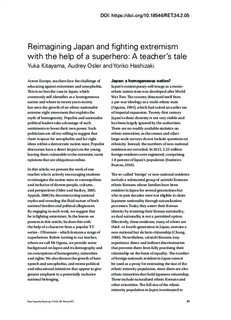Reimagining Japan and fighting extremism with the help of a superhero: a teacher’s tale
Journal article, Peer reviewed
Published version
Permanent lenke
http://hdl.handle.net/11250/2501909Utgivelsesdato
2017Metadata
Vis full innførselSamlinger
Originalversjon
Race Equality Teaching. 2017, 32 (2), 21-27.Sammendrag
Across Europe, teachers face the challenge of educating against extremism and xenophobia.This is no less the case in Japan, which commonly self-identifies as a homogeneous nation and where in recent years society has seen the growth of an ethno-nationalist extreme-right movement that exploits the myth of homogeneity. Populist and nationalist political leaders take advantage of such sentiments to boost their own power. Such politicians are all too willing to suggest that there is space for xenophobic and far-right ideas within a democratic nation state. Populist discourses have a direct impact on the young,leaving them vulnerable to the extremist, racist opinions that are ubiquitous online.In this article, we present the work of one teacher who is actively encouraging students to reimagine the nation state as cosmopolitan and inclusive of diverse people, cultures,and perspectives (Osler and Starkey, 2005; Appiah, 2006) by deconstructing national myths and revealing the fluid nature of both national borders and political allegiances.By engaging in such work, we suggest that he is fighting extremism.In the lesson we present in this article, he does this with the help of a character from a popular TV series – Ultraman – which features a range of superheroes. Before turning to our teacher,whom we call Mr Ogawa, we provide some background on Japan and its demography and on conceptions of homogeneity, minorities and rights. We also discuss the growth of hate speech and xenophobia, and recent political and educational initiatives that appear to give greater emphasis to a potentially exclusive national belonging.

